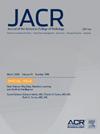ACR Appropriateness Criteria® Imaging of Suspected Intracranial Hypotension
IF 4
3区 医学
Q1 RADIOLOGY, NUCLEAR MEDICINE & MEDICAL IMAGING
引用次数: 0
Abstract
The clinical syndrome of intracranial hypotension refers to the symptoms caused by cerebrospinal fluid hypovolemia and is primarily characterized by postural headaches, but can be associated with a multitude of other neurological symptoms. Imaging plays a critical role in helping to establish a diagnosis of intracranial hypotension, localize the source of cerebrospinal fluid leak, and assist in directing targeted treatments. Using the best available evidence, this document provides diagnostic imaging recommendations for the workup of intracranial hypotension across various clinical presentations.
The American College of Radiology Appropriateness Criteria are evidence-based guidelines for specific clinical conditions that are reviewed annually by a multidisciplinary expert panel. The guideline development and revision process support the systematic analysis of the medical literature from peer reviewed journals. Established methodology principles such as Grading of Recommendations Assessment, Development, and Evaluation or GRADE are adapted to evaluate the evidence. The RAND/UCLA Appropriateness Method User Manual provides the methodology to determine the appropriateness of imaging and treatment procedures for specific clinical scenarios. In those instances where peer reviewed literature is lacking or equivocal, experts may be the primary evidentiary source available to formulate a recommendation.
ACR 适当性标准® 疑似颅内低血压的成像。
颅内低血压临床综合征是指脑脊液容量不足引起的症状,主要表现为姿势性头痛,但也可能伴有其他多种神经系统症状。影像学检查在帮助确定颅内低血压的诊断、定位脑脊液漏的来源以及协助指导针对性治疗方面起着至关重要的作用。本文件利用现有的最佳证据,为不同临床表现的颅内压低症提供了影像学诊断建议。美国放射学会适宜性标准是针对特定临床病症的循证指南,每年由一个多学科专家小组进行审查。指南的制定和修订过程支持对同行评审期刊上的医学文献进行系统分析。既定的方法原则,如 "建议评估、发展和评价分级"(GRADE),被用来评估证据。兰德/加州大学洛杉矶分校《适宜性方法用户手册》提供了确定特定临床情况下成像和治疗程序适宜性的方法。在缺乏同行评议文献或文献不明确的情况下,专家可能是制定建议的主要证据来源。
本文章由计算机程序翻译,如有差异,请以英文原文为准。
求助全文
约1分钟内获得全文
求助全文
来源期刊

Journal of the American College of Radiology
RADIOLOGY, NUCLEAR MEDICINE & MEDICAL IMAGING-
CiteScore
6.30
自引率
8.90%
发文量
312
审稿时长
34 days
期刊介绍:
The official journal of the American College of Radiology, JACR informs its readers of timely, pertinent, and important topics affecting the practice of diagnostic radiologists, interventional radiologists, medical physicists, and radiation oncologists. In so doing, JACR improves their practices and helps optimize their role in the health care system. By providing a forum for informative, well-written articles on health policy, clinical practice, practice management, data science, and education, JACR engages readers in a dialogue that ultimately benefits patient care.
 求助内容:
求助内容: 应助结果提醒方式:
应助结果提醒方式:


